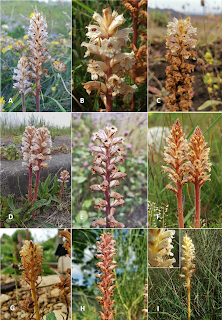The second day of the New Year Plant Hunt dawned and it was still miserable weather for many of us. But there were group hunts planned in many locations; a glance at the Results board this morning showed that only c300 species had been recorded on Day One, so there was obviously more to find; and botanists are a hardy bunch so.... a-hunting we went!
Botanising with friends and family, or in organised groups, is always a real theme of the Hunt and today was no exception. Michael Jones' 8-month old daughter was wrapped up warmly and (judging by the image on right taken by Michael) seems to have really enjoyed using our spotter sheet of Top 20 plants to check what to look for during the Hunt! The spotter sheets were new this year and first-time plant hunters of all ages have found them very useful.
On the Results page, where you'll find the list of most frequently recorded plants (the ones we used when compiling the spotter sheets), a new feature for this year is that our IT wizard Tom Humphrey has put little arrows in to show whether a species is being recorded in bloom more or less frequently than last year. So it looks as though Hazel, Winter Heliotrope and White Dead-nettle are going 'up the charts' but Red Dead-nettle, Shepherd's-purse and Hogweed are going down. Is that what you're finding in your area? Daisy retains it's supreme position as number one on the list.
So who else was out hunting with friends and family? In Co. Cork, the Glengarriff team notched up 35 species in bloom, more than the Sligo team yesterday - but Sligo botanists had a rainbow for compensation! The Cornish botanists had a great day out in Mevagissey today and found 76 species in bloom. Their list is here, at the top of the list of longest lists (for now!) Fewer species to be found up in in Newcastle, where James Common was out again - it's only Day Two but he was on his third Hunt, this time with partner Matt and they found musk mallow blooming by a bus stop (image on left). Urban and suburban habitats like this often yield the most interesting plant finds.
Community is an important part of botanising - to enjoy great company and also for sharing ID tips. In Hertfordshire, the Grow Community - Sopwell team (image on right) enjoyed botanising together on their group hunt. There are still quite a few group hunts scheduled for the next two days so do check them out if you'd like some company on your hunt.But many of us also enjoy a solo Hunt - a bit of quiet time to recharge our batteries. In Lancashire, Rose Edmondson did her first ever New Year Plant Hunt, inspired by Leif Bersweden's book and armed with the Top 20 spotter sheet.
Neil Forbes was out in Arnside and found Spring Sandwort (image below left). With a handlens, he could see anthers sticking out so that counted as 'flowering' and was therefore eligible for the Hunt. Neil also noticed the impact of both microclimate and proximity to the coast on the abundance and status (native or non-native) of the species blooming in the various locations he visited.
Southern locations tend to have more species in bloom - for example, Kate Gold found 31 species in bloom in East Sussex yesterday, following the same route she's been going since 2016 - whereas further north today, Margaret Cahill in Offaly and Joanie McNaughton in Edinburgh both found slimmer pickings.
But understanding more about which wild and naturalised plants manage to bloom where, and how this correlates with autumn and winter weather patterns, is what makes the New Year Plant Hunt so interesting. So well done to those northern plant hunters who braved the cold and went out to see what they could find in bloom.
By 10pm, when we had just about reached the halfway point of this year's Hunt, the Results board showed that plant hunters had uploaded details of more than 700 surveys and the total number of species recorded in bloom had risen to 439. Great work everyone!
What will tomorrow bring? I'm leading a hunt around a Leicester industrial estate in the afternoon and look forward to seeing how our count compares with previous years at the same location. My colleague James Harding-Morris, the mastermind behind those great spotter sheets, will be here in the evening to summarise Day Three findings for you.
Happy hunting and fingers crossed for decent weather!













